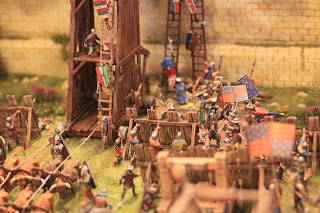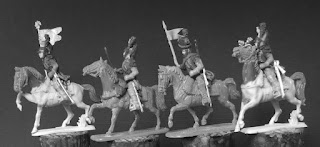with the 2nd Dioramica comming closer (ok, 6 month left), I thought I can show you some photos from the 2016 exhibition.
These are the photos I made from a medieval siege diorama which was on show.
We are a group of Enthusiasts from all over the world, mostly Germany, who create historical battles in scale 1:72. As we do this since more than 10 years we thought it is time for our own blog. Being a historical enthusiast I wanted to fulfill my dream of producing my own figures in this scale too. So I started working with several sculptors to produce exotic figures in 1:72 which I fear nobody else would bring on the market.
Samstag, 23. Juni 2018
Dienstag, 19. Juni 2018
French Dragoon command
In the last years Pieter focused (between other things) on the Peninsular war. Now we have a new set for his range. He already has three sets of French dragoons and now finally we have command figures for them.
See here the photos of masters Massimo sent over
See here the photos of masters Massimo sent over
Freitag, 15. Juni 2018
Marengo 14.06.1800
Hi guys,
I now I am a day too late. But Frank had a secret, sculpting a special unit which should hit the public on the aniversary of the battle.
But with the beginning of the World-Championship yesterday I had other things in mind than checking my mails....
So here I can show you the latest set in our range of the French Revolution - French 9th light infantry in the campaign of 1800. Here Frank's text:
I now I am a day too late. But Frank had a secret, sculpting a special unit which should hit the public on the aniversary of the battle.
But with the beginning of the World-Championship yesterday I had other things in mind than checking my mails....
So here I can show you the latest set in our range of the French Revolution - French 9th light infantry in the campaign of 1800. Here Frank's text:
Here are my Incomperables in 1:72
In my research, since I've been working on Napoleonic uniforms for over half a year, I came across the illustrious Osprey Campaign book "The Battle of Marengo" by David Hollins, and Terry Crowdy's book "Incomperables", in which there is a detailed report of the combat action around the 9th light infantry.
In my research, since I've been working on Napoleonic uniforms for over half a year, I came across the illustrious Osprey Campaign book "The Battle of Marengo" by David Hollins, and Terry Crowdy's book "Incomperables", in which there is a detailed report of the combat action around the 9th light infantry.
So, after my firing fusilliers for the Armée d'Orient, I had left the prepared dollies. Well, a few years ago, a well known colleague modeled firing Fusiliers, so I thought how about light infantry with the shortened uniform and bicorn? Anyway I think bicorns are looking more appealing than shakos; these bicorns in combination with the shortened uniform jacket- according to my educated guess ca. 1796-1800.
The famous painting by Lejeune, which depicts the ranks of the 9th light infantry shortly before the decisive attack at Marengo, shows the shakos, which are quite possible in that time, but you can always expect anachronisms in such paintings. By the way, Coucelle and Funcken also interpreted the shakos for 1800, while André Jouineau portrays light infantry for 1800 with the bicorn and partly with a long-cut uniform jacket on his boards. Christa Hook also draws the bicorn, but in combination with the short-cut uniform jacket. For example, Carl Achard even draws the 14e Legères around 1800 with the long-cut uniform jacket and mirliton.
Another rather naïve depiction (Cronaca Rovatti?), which I found in the www, with no further information except the year 1800, represents the short-cut uniform and the bicorn; in a front view it is the blue French light infantry uniform, the rear view is a dark green uniform, presumably the Legion Italique in ca. 1800, but the bicorn without any plume ...
Also, I knew this uniform of reenactment videos on Youtube from the 9e demi-brigade de infanterie legére, and I know a three rank stripes-veteran of them.
The famous painting by Lejeune, which depicts the ranks of the 9th light infantry shortly before the decisive attack at Marengo, shows the shakos, which are quite possible in that time, but you can always expect anachronisms in such paintings. By the way, Coucelle and Funcken also interpreted the shakos for 1800, while André Jouineau portrays light infantry for 1800 with the bicorn and partly with a long-cut uniform jacket on his boards. Christa Hook also draws the bicorn, but in combination with the short-cut uniform jacket. For example, Carl Achard even draws the 14e Legères around 1800 with the long-cut uniform jacket and mirliton.
Another rather naïve depiction (Cronaca Rovatti?), which I found in the www, with no further information except the year 1800, represents the short-cut uniform and the bicorn; in a front view it is the blue French light infantry uniform, the rear view is a dark green uniform, presumably the Legion Italique in ca. 1800, but the bicorn without any plume ...
Also, I knew this uniform of reenactment videos on Youtube from the 9e demi-brigade de infanterie legére, and I know a three rank stripes-veteran of them.
With the backpacks, I went a bit away from the stylization, the soldiers in appez des armes, have, as often seen on reenactment photos, back down creasing backpacks, because they had no stiffenings. Then, every third figure got a pair of overpants instead of the tight-fitting light infantry trousers with short gaiters. Another variation is represented by the bottles; calabases, tin canteens and braided in bottles.
From a modeling point of view, most of the heads have been given more uniform proportions by a stamp for the face - giving me more time to devote myself to individual physiognomy.
With these figures, of course, the bicorn is the individual detail that I particularly like. So, for example, we have the four different types in apprez des armes which have their individual style wearing the bicorn; maybe with the next figures, the loading ones, I will sculp an additional firing rifleman with another slanted seated bicorn.
But we will see, what's next; these incomperables are missing commando figures etc. too....
From a modeling point of view, most of the heads have been given more uniform proportions by a stamp for the face - giving me more time to devote myself to individual physiognomy.
With these figures, of course, the bicorn is the individual detail that I particularly like. So, for example, we have the four different types in apprez des armes which have their individual style wearing the bicorn; maybe with the next figures, the loading ones, I will sculp an additional firing rifleman with another slanted seated bicorn.
But we will see, what's next; these incomperables are missing commando figures etc. too....
Greetings
Frank
Dienstag, 12. Juni 2018
Rainer's 30 YW project
Rainer is working on some small 30YW dioramas for the museum in his hometown.
I thought you also might like to see the photos.
Two weeks ago the was the aniversary of the battle of Rocroi and my friend Schmitty put our diorama on display there. Hopefully I can show some pictures very soon.
I thought you also might like to see the photos.
Two weeks ago the was the aniversary of the battle of Rocroi and my friend Schmitty put our diorama on display there. Hopefully I can show some pictures very soon.
Dienstag, 5. Juni 2018
A charge at Murten 1476
Our hobbyfriend Konrad Schlangen sent us these great photos of Frank's Pikemen.
Since our hobbytour through Switzerland last year this is for sure a subject for a future project of mine too.
Since our hobbytour through Switzerland last year this is for sure a subject for a future project of mine too.
Sonntag, 3. Juni 2018
More photos from Borodino
Norbert Richem sent me the latest photos of his Borodino project which I want to share with you. Showing dioramas always is fun for me.
And I like Norbert's style of educating people, explaining the battle and showing how he made it.
And as it fits to the subject, here two photos I got from "Foy" (see my blog-list). He painted several units of Hinton-Hunt Bavarian infantry. You see Raimund's Bavarians from Falcon working very good with them.
And I like Norbert's style of educating people, explaining the battle and showing how he made it.
And as it fits to the subject, here two photos I got from "Foy" (see my blog-list). He painted several units of Hinton-Hunt Bavarian infantry. You see Raimund's Bavarians from Falcon working very good with them.
Abonnieren
Kommentare (Atom)

























































